Are you looking for a satisfying China Yangtze River Cruise tour? Do you expect to explore more cities apart from the Yangtze River Cruise? This well-designed 13 days China Yangtze River Cruise tour will take you to enjoy the fascinating natural sceneries along the Yangtze River. You will go on a Yangtze cruise from Chongqing and sail downstream to visit the Three Gorges of the Yangtze River. What’s more, entering the Forbidden City in Beijing to see the magnificent royal palaces, visiting the Terracotta Warriors and Horses Museum in Xi’an to take a look at the Eighth Wonder of the World, exploring the Chengdu Research Base of Giant Panda Breeding in Chengdu to encounter the adorable giant pandas, and ascending Oriental Pearl TV Tower in Shanghai to overlook this modern city will definitely surprise you. Don’t hesitate and join us right now!

Welcome to Beijing, the capital of China. Beijing is a metropolis covering an area of more than 16,000 square kilometers with a population of over 21 million. As China’s center of politics and culture, Beijing attracts an increasing number of people across the world every year. Upon arrival, our guide holding your name sign will pick you up at the airport and then take you to the downtown hotel and help you check in. Beijing is the first stop of your Yangtze River Cruise Tour, and we hope you can enjoy yourself.
This morning, your tour will begin by sightseeing Tian’anmen Square, which is located in the center of Beijing. Tian’anmen Square is a sacred place for holding solemn celebrations with numerous people gathering. Tian’anmen Square represents a traditional Chinese style. You will see the National Flagpole, the Monument to the People’s Heroes, the Chairman Mao Memorial Hall in the square. There is a river in front of Tian’anmen Square called Jinshui River, and across the river straddle seven bridges. In ancient China, these bridges allowed different people to go through, embodying the strict hierarchy of the feudal society. The bridge in the middle is the widest bridge among the seven bridges. It is called the “Imperial Road Bridge” and only the emperor could walk on it. The two bridges next to the “Imperial Road Bridge” are a little narrower. They are called “Lord Bridge”, which were for the royal family members to walk. The two next to the “Lord Bridge” were used by high-ranking officials. The remaining two bridges were used by low-ranking officials, soldiers, and servants.
Then continue going north, you will enter the Forbidden City (closed each Monday), which is the imperial palace for the Ming and Qing (1636-1912) dynasties. The Forbidden City is located in the center of the axis of Beijing. It is the largest and the best-preserved wooden architecture in the world. There is a well in the Forbidden City named Lady Pearl’s Well, into which Pearl Concubine was pushed. The story has it that in the latter decades of the Qing Dynasty, Beijing was in a war and Empress Dowager Ci Xi and Emperor Guangxu were forced to escape from the Forbidden City. Pearl Concubine was the most beloved concubine of Emperor Guangxu but was deeply hated by Empress Dowager Ci Xi. Before leaving Beijing, Empress Dowager Ci Xi ordered her eunuch to kill Pearl Concubine. Hence, the eunuch named Cui Yugui pushed Pearl Concubine into this well. This is why the well is called Lady Pearl’s Well.
After lunch, you will explore the Summer Palace. It was an imperial garden in the Qing Dynasty, built by extracting garden design techniques in South China. Later generations heap great praise on it and regard it as “Royal Garden Museum”. In 1998, the Summer Palace was included in the World Heritage List, and countless visitors are attracted to visit this summer resort every year. In the northwest of Kunming Lake, you will see the Marble Boat. It was first built during Emperor Qianlong’s reign. In the late Qing Dynasty, it was rebuilt by a Minister of Defense who wanted to cater to Empress Dowager Ci Xi, the real ruler of the late Qing Dynasty. Therefore, some people think that the appearance of the boat bears resemblance to a warship.
Option: In the evening, you will visit Red Theatre to watch a magnificent Kung Fu show, Legend of Kung Fu Show. The performance often begins at 19:30 and ends at 21:00. In the busy season, there will be one more performance at 17:15.
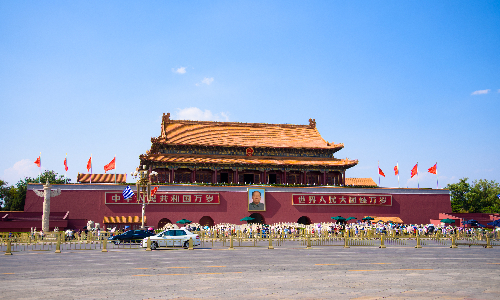
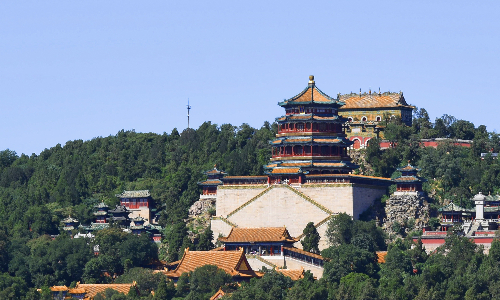
After breakfast, you will visit the Temple of Heaven. It covers 2,730,000 square meters, four times the area of the Forbidden City. Located in the south of Beijing, the Temple of Heaven served as a sacred place where emperors of the Ming and Qing dynasties offered sacrifices to heaven and pray for a good harvest. The main building of the Temple of Heaven is the Hall of Prayer for Good Harvests that was built in 1420. It is unique in terms of its internal structure. You will see there are 28 pillars in the hall. They are arranged in three circles and each circle has a different meaning. Four “Dragon Well Pillars” of the inner circle represent the four seasons; the middle twelve “Golden Pillars” symbolize the twelve months of a year; the twelve “Eave Pillar” of the outer circle symbolize twelve hours (In ancient China, a day was divided into twelve hours and one hour at that time is equal to two hours at present.).
After visiting the Temple of Heaven, you will go to Old Beijing Hutong. A Hutong is a lane in the old town of Beijing. Numerous Hutongs crisscrossing with local folk houses on both sides of Hutongs form the traditional residential quarters of Beijing. There are over 7,000 Hutongs in Beijing and the ways to name Hutong also vary. Some Hutongs are named according to their features or landscapes. For example, a Hutong is named Lotus Pond Hutong because there used to be a lotus pond at one end of the Hutong. Some Hutongs are named according to different functions. For example, West Flower Market Street and East Flower Market Street were named because they served as a flower trade market at that time. You can take a rickshaw to explore the unique charm of different Hutongs. After cursory sightseeing of Hutong, the guide will lead you to a specific quadrangle dwelling to experience Beijingers’ life.
After lunch, you will go to the Mutianyu Great Wall, which is 73 kilometers away from downtown Beijing. We will drive northwest for about one and a half hours to get there. The Great Wall was built to fend off the invasion of northern tribes. Therefore, ancient rulers attached great importance to the project and continuously maintained the old walls and built new walls. When it comes to the Great Wall, people take delight in visiting the Mutianyu Great Wall because of its winding mountains and forest coverage. There are three ways to go up and down the Mutianyu Great Wall. First, you can take a cable car, which is a good choice for elderly people. Besides, these cable cars are entirely closed and completely safe. Second, you can take an open-air chairlift, which is a bit more exciting than taking a cable car. The last one is taking a chairlift to the top and then taking a toboggan down, which is more adventurous and breathtaking compared to the other two ways.
Option: In the evening, you can also visit Silk Street if you still feel energetic. It closes at late night. You can buy some gifts with traditional Chinese characteristics for your family members and friends, such as silk clothes, tea, handcrafts, and lower-priced brand-name bags.
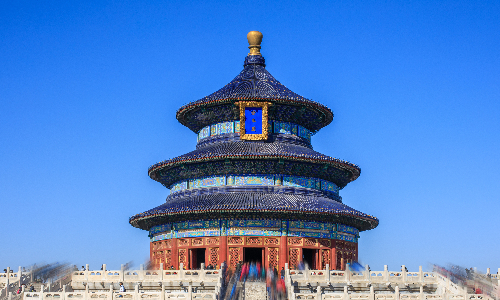
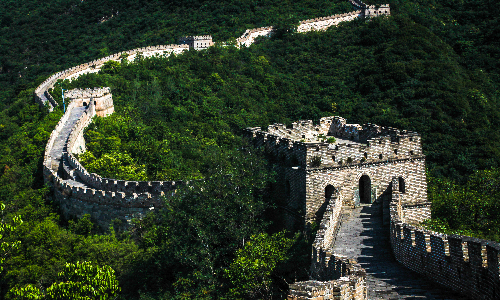
 Xi’an
Xi’an After checking out, you will be driven to the train station and take the estimated train G571 09:22/15:06 to Xi’an. It is the hub of Northwest China. It has a population of more than 12,900,000 and covers over 10,000 square kilometers. Xi’an impresses people across the world with its long history. It has served as the ancient capital for thirteen dynasties. The Terracotta Warriors, the Wild Goose Pagoda as well as Huaqing Hot Spring are representative attractions of Xi’an. Xi’an is also famous for its delicious food such as Roujiamo, an equivalent to American-style hamburger. Therefore, Xi’an is an indispensable stop of your Yangtze River Cruise Tour.
After arriving in Xi’an, your Xi’an tour guide will take you to the hotel and help you check in, and then you can have a nice rest.
Option: You can visit Grand Tang Mall if you want to explore Xi’an by yourself. Grand Tang Mall is a pedestrian street with Tang-style buildings and ornaments. It is a famous place that a lot of online celebrities come here to take photos and videos. Taking a stroll around the Grand Tang Mall can help people escape from the fast-paced modern life and immerse in a relaxing atmosphere.
After breakfast, you will visit the Terra Cotta Warriors and Horses Museum, which is located 43 kilometers northeast of Xi’an, and it takes about 40 minutes from the center of the city to the museum. It is said that the Terracotta Warriors and Horses were designed by Li Si, the prime minister of the Qin Dynasty (221-207 BC). It is an indispensable part of the Mausoleum of the First Qin Emperor, which took 39 years to be completed with millions of people engaging in the project. At present, more than 8,000 terracotta warriors and horses have been unearthed. Significantly, these warriors and horses not only are vividly designed with different costumes and gestures, but also have different appearances. Some warriors just stand at attention with their hands by their sides. Some warriors take a squatting position with their backs straight and right knees touching the ground. They were the most complete terracotta warriors when they were unearthed at the very beginning.
After lunch, you will visit Big Wild Goose Pagoda, which has been listed on the World Heritage List. The story has it that Xuan Zang, a well-known Buddhism master in China, asked emperor Gaozong of the Tang Dynasty (618-907) to build a pagoda to store and protect Buddhist scriptures. How did the pagoda get this name? When Xuan Zang went to ancient India to study Buddhism and acquire Buddhist scriptures, he heard a legendary story from local Buddhist monks. The story narrated that a wild goose killed itself to prevent several Buddhist monks from starving. To commemorate the wild goose, these monks built a pagoda and named it Wild Goose Pagoda. Xuan Zang later visited the pagoda with reverence. After returning to China, he built the pagoda molded after the Wild Goose Pagoda in India and people called it Big Wild Goose Pagoda to distinguish them.
After visiting Big Wild Goose Pagoda, you can also visit the City Wall, which has a large number of ornaments including lanterns, flags, and lights, providing you with a lot of fun. You can walk on the wall to enjoy the beautiful scenery of Xi’an City. You can also ride bikes on the wall. Both single-seat and double-seat bikes are available. Riding a bike on the City Wall has become the most popular way among visitors from home and abroad. What’s more, you will see soldiers in armors patrolling on the wall. You can take pictures with them and post them on your social media. You may get a lot of “likes” and new followers.
Option: In the evening, you can go to Tang Dynasty Palace to enjoy a fabulous performance of singing and dancing – Empress of the Great Tang. The whole performance portrays the unprecedented and legendary life of Wu Zetian, the only female emperor of the Tang Dynasty. It highly restored the Tang-style music and dance, which will bring the audience back to the glorious Tang Dynasty. After the performance, you will have a dumpling feast.
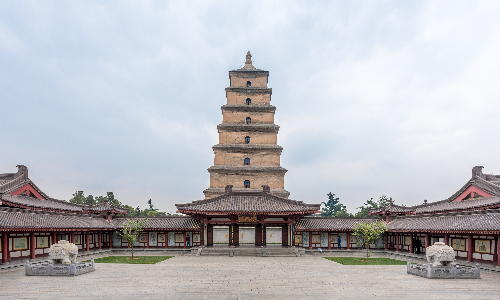
 Chengdu
Chengdu After breakfast, you will take the estimated train G89 11:28/14:38 to Chengdu, which enjoys the reputation of being a “Heavenly Land of Plenty”. Chengdu is located in Chengdu Plain with highly developed agriculture and abundant natural resources. It is also renowned as the best tourist city. Therefore, it is a good choice to visit Chengdu on our Yangtze River Cruise Tour.
In the afternoon, you can hang out in People’s Park, where you can take part in many activities to experience the slow-paced Chengdu life. The most popular activity among Chengdu locals is to sip tea at Heming Teahouse. You can sit at a small table and order a pot of tea. You should smell the aroma of the tea first and then take a sip slowly. You can also have a small talk with local people around you to learn about the tea culture in Chengdu.
After finishing the People’s Park, you will visit Kuan Zhai Alley, which literally means wide and narrow alley. Kuan Zhai Alley consists of Kuan Alley, Zhai Alley, and Jing Alley, three pedestrian streets. It is the largest Qing Dynasty-style street existing in Chengdu and one of the most famous commercial streets in China, where snacks, souvenirs, and specialties are provided. A special activity called Ear Cleaning is popular among visitors. It is common to see that a crowd of men standing in a queue to clean their ears. You can have a try. After Ear Cleaning, your ear wax will get removed and you will feel comfortable.
Option: Hot Pot is the first specialty that every Chinese can think of when it comes to Chengdu. Therefore, eating Hot Pot is an indispensable part of your trip to Chengdu. People in Chengdu began to eat spicy and hot food thousands of years ago. They believed that eating spicy and hot food could help them get rid of diseases because of a damp climate. To save time, ancient people put a variety of ingredients such as mutton, beef, and potatoes into a pot and boiled them together at the beginning. Thus, the Hot Pot began to take shape and gradually develop into one of the most popular food in China and even in the world.
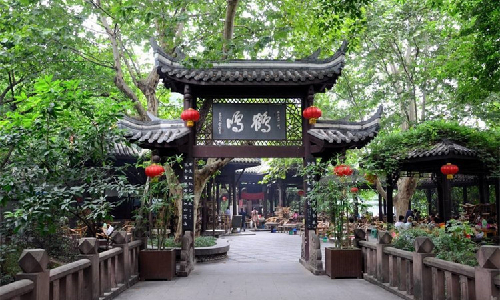
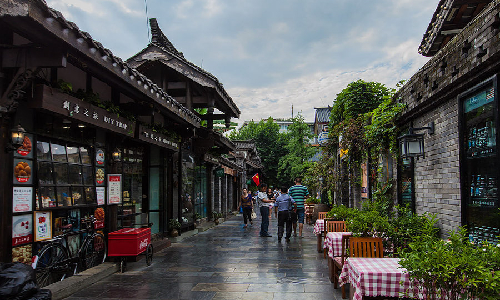
After breakfast, you will visit Leshan Giant Buddha, which is located 170 kilometers southwest of Chengdu. It takes about two hours to get there by car. Leshan Giant Buddha is the largest stone-carved sculpture in China. The Buddha is a seated Maitreya Buddha with a total height of 71 meters, and it is as high as the mountain behind it. Three rivers, namely Dadu River, Qingyi River, and Min River, converge at the feet of the Giant Buddha. In ancient times, the turbulent current here often capsized ships railing through this area, causing death or severe damage to the people. To tackle the problem, Haitong Master took on the responsibility to build a Buddhist sculpture – the Leshan Giant Buddha for blessing people. After Haitong Master died, his apprentices kept building the sculpture in the following 90 years.
In the afternoon, you will pay a visit to Huanglongxi Ancient Town on the way to Chengdu. Huanglongxi Ancient Town is one of the top ten water towns in China with more than 1,700 years of history. This town is an ideal place for film shooting because of its antique scenery. More than 100 movies have been completed here so far, so Huanglongxi Ancient Town also enjoys a reputation of “Chinese Hollywood”. Apart from that, a traditional food in Huanglongxi Ancient Town called “longevity noodles” is hugely popular among visitors. Originating from Song Dynasty (960-1279), it is a single long noodle indicating that good things will last long. At that time, each family would make this kind of noodle by hand to celebrate festivals or happy events. Later, it was only eaten on birthdays, called “longevity noodles”.
Option: You can also visit Shufeng Yayun Sichuan Opera House to enjoy the face-changing performance, the highlight of the Sichuan Opera. During the performance, the actor changes his vividly colored masks in less than a second. You will be shocked by the magical performance and enchanted by the colorful masks.
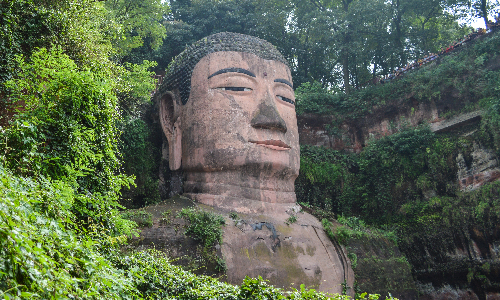
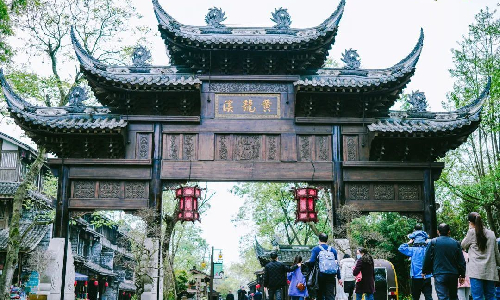
 Chongqing
Chongqing After breakfast, the guide will lead you to the Chengdu Research Base of Giant Panda Breeding. Pandas are quite active in the morning. Therefore, it is advisable for you to observe pandas in the morning. Every morning, breeders would “tempt” pandas with apples and bamboos, and pandas would scramble for food. Maybe you will see that a breeder holds a long pole with an apple hanging on one end to attract pandas and try to make them stand up, which can help giant pandas exercise. It is very common to find that some pandas sit on the ground and eat bamboos. You will be amazed by their adept skills of peeling off the bamboo skin. And you will be enchanted by their adorable gestures and manners.
Out of Chengdu Research Base of Giant Panda Breeding, your lunch will be served at a local restaurant. After lunch, the guide will accompany you to the train station and you will take the estimated train G2887 15:07/16:32 to Chongqing City. After arriving in Chongqing, your Chongqing tour guide will pick you up to Chaotianmen Dock, where you will take the Yangtze River Cruise. Chaotianmen Dock is located 20 kilometers northeast to Chongqing West Railway Station and it takes about half an hour to get there by car. Then the guide will help you go through the boarding procedures and then he or she will get off the cruise ship. You are supposed to go onboard before 20:30 and the cruise ship will embark at 21:00. The cruise ship is equipped with a variety of facilities such as bar, tea house, cafe, which bears resemblance to a holiday hotel. What’s more, you will enjoy western buffets on the cruise ship.
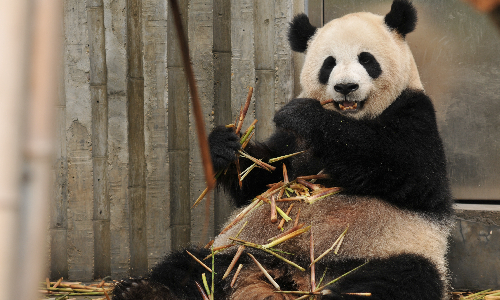
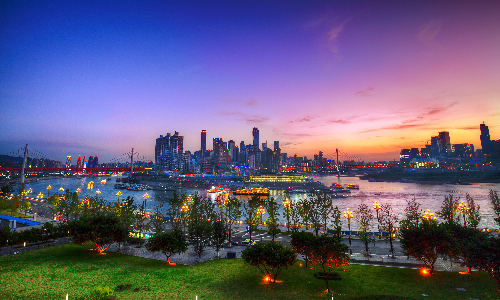
Today, you can sleep until wake up naturally. After finishing the morning wash, you can go to the dining room to have your breakfast. This morning, the cruise ship will offer a wide variety of breakfast buffets. You will enjoy a substantial breakfast. After finishing your breakfast, you could engage yourself in the Tai Chi activity. As an ancient form of exercise, Tai Chi helps you alleviate stress and keep healthy. Perhaps, you could take a sip of coffee while enjoying the beautiful natural views on the deck of the cruise ship. These activities are conducive to helping you relax so that you can stay away from exhaustion and store energy for your following trip.
Today you will have a shore excursion and visit Shibaozhai Pagoda. It becomes world-famous because of its unique building structure and is honored as one of the eight fantastic buildings in the world. Shibaozhai Pagoda leans against a huge boulder on the north bank of the Yangtze River. According to ancient Chinese legend, this huge boulder was a colorful stone left by Goddess Nuwa when she mended the sky. The whole pagoda is divided into two parts, three floors on the top of the boulder and nine floors below. Seen from a distance, this 12-floor pagoda with flying eaves towering by the Yangtze River is quite magnificent and attractive. Since Shibaozhai Pagoda was open to the public in 1979, it has receives 220,000 tourists on average every year.
You are also expected to pay an extra charge to visit Fengdu Ghost City. It is a famous historical and cultural city that originated in the Han Dynasty (202 BC-220 AD), with a history of nearly 2,000 years. Why is it called a ghost city? Is there any ghost in this place? Of course not. Fengdu Ghost City is famous for a number of underworld buildings, such as Naihe Bridge, Huangquan Road, and Wangxiang Platform. Naihe Bridge is the place that the ghosts must walk through before reincarnation. Huangquan Road is 50 meters long and 2 meters wide, paved with grey slates. It is the road leading the ghosts to the underworld after the people die. Wangxiang Platform is where the ghosts can see their families living in the earthly world. It is the home of the dead, also known as the “Capital of Ghost Kingdom”. It is the most popular underworld cultural landscape on the Yangtze River Cruise and you cannot miss it.
You need to be aware that attractions vary according to different cruise ships. Therefore, the attractions are arranged in light of your actual reservation.
In the evening, the captain will hold a welcome reception. You can take part in the party and communicate with other fellow travelers.
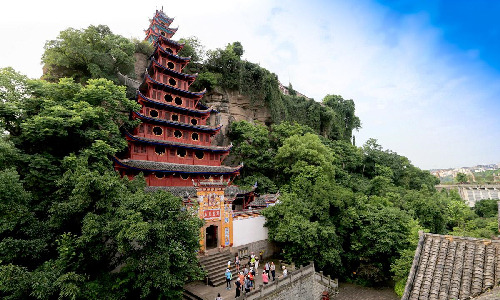
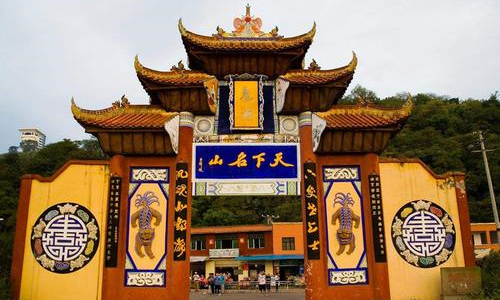
After having a self-help breakfast in the morning, you can practice Tai Chi to relax and refresh. Today you will sail through the Three Gorges of Yangtze River, namely Qutang Gorge, Wu Gorge, and Xiling Gorge. The Three Gorges scenic area with a total length of 193 kilometers is famous for the peculiar peaks and steep cliffs standing on both sides of the Yangtze River. You will first sail through Qutang Gorge where you will take an Additional Shore Excursion to visit White Emperor City. The White Emperor City was built on the White Emperor Mountain, which was applied to defend against enemies. Do you know the origin of its name? In the late Western Han Dynasty (202 BC-8 AD), Gongsun Shu occupied this area and proclaimed himself emperor. He built a city on the mountain. In the city, there was a well and people often saw white smoke came from the well, like a white dragon. In ancient times, the dragon was a symbol of imperial power and monarch. Therefore, Gongsun Shu proclaimed himself “White Emperor” and named the city “White Emperor City”. When you come to Wu Gorge, you will take a small boat to visit the Goddess Stream, a 15-kilometer-long stream. Goddess Stream is famous for the precipitous cliffs and primitive forests on both sides of it. Sailing along the Goddess Stream, you will feel like you were winding through an otherworldly world.
This evening, the captain will hold a farewell party and the crew will also involve in a wonderful performance. You enjoy this evening to the full.
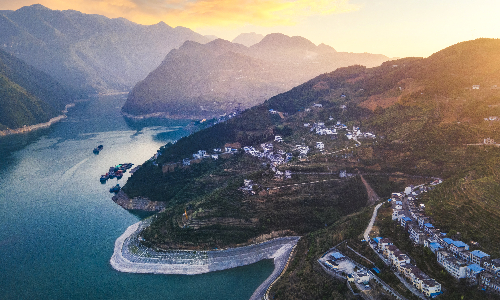
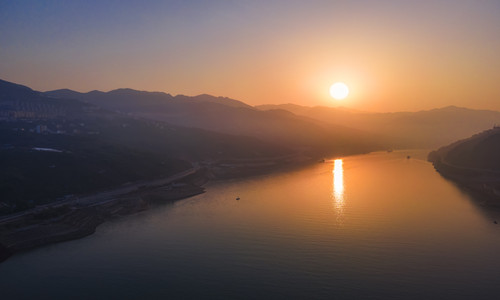
 Shanghai
Shanghai After breakfast, you will visit the Three Gorges Dam Site, the largest-scale hydropower station in the world. The electric capacity generated by the Three Gorges Dam takes up 20% of the country’s electricity capacity. You would have an Additional Shore Excursion at the Three Gorges Dam Site. You are going to board a sightseeing-ferry and sail across the Three Gorges Dam by taking the TGP Ship’s elevator, which requires additional charges.
After the Three Gorges Dam Site, you will go to Yichang Three Gorges Center Cruise Terminal by car and then be transferred to the train station in Yichang. You will take the estimated train D354 14:46/22:21 to Shanghai.
After arriving in Shanghai, the guide will greet you at the airport and transfer you to the hotel. Shanghai is the terminal of your Yangtze River Cruise Tour. It covers more than 6,000 square kilometers with a population of 24 million. Shanghai is where modern style and traditional flavor converge. Therefore, you can find both skyscrapers and Chinese-style buildings here.
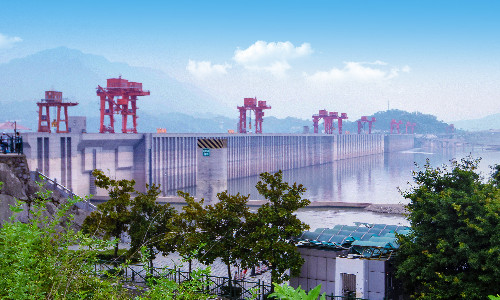
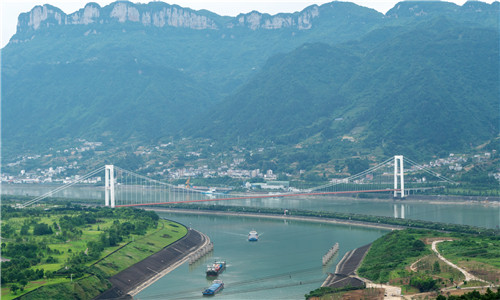
After breakfast, the guide will lead you to Yu Garden (closed on Monday). It has more than 400 years of history and is a private garden in the Ming dynasty. An official called Pan Yunduan built the garden for the sake of filial piety. To help his father live in comfort during his late years, Pan Yunduan decided to build the garden and named it “Yu”, which refers to safety and peace in Chinese. However, his father died before Yu Garden was completed. In 1999, Jiang Zemin, one of the leaders of China, inscribed the garden with “A Well-Known Garden on the Sea” to commemorate the 440th anniversary of its completion.
After visiting Yu Garden, the guide will lead you to Shanghai Old Street, a commercial street with a large number of commodities transacted here in ancient times. Now, Shanghai Old Street is a multifunctional street where tourism, business, entertainment and cultural industries flourish. Taking a stroll along the street, you can buy many traditional Chinese gifts such as fans, silk scarfs, and paper-cuts.
After lunch, you will visit the Oriental Pearl TV Tower, one of the most famous landmarks in Shanghai. The tower with a total height of 468 meters stands by the side of the Huangpu River. Even though it is a TV tower, it is a multifunctional building including sightseeing, catering, shopping, and entertainment. Today, you will ascend the Oriental Pearl TV Tower to overlook the whole city. You will witness a brilliant and beautiful Shanghai.
Then, the guide will lead you to Nanjing Road, a commercial street selling luxury goods in Shanghai. It is one of the most famous commercial pedestrian streets in China, attracting 800,000 people on average every day. You can find flagship stores of renowned brands, such as Apple’s Flagship Store, Huawei Flagship Store, and Lego Flagship Store.
Last, you will reach the Bund. It used to be the place where financial activities and foreign trades were first launched in Shanghai. At present, it is most famous for the 52 classical western-style buildings here. You will take a leisure walk to admire these old buildings as well as the skyscrapers opposite the Bund.
Option: You can take a Huangpu River Night Cruise (about an hour) to enjoy the wonderful night landscapes on both sides of the Huangpu River.
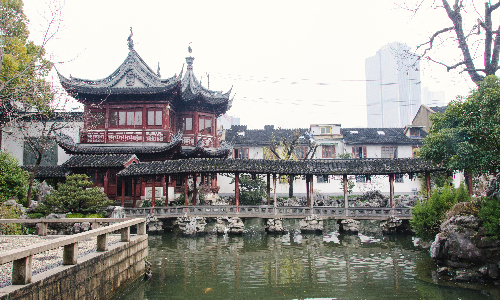
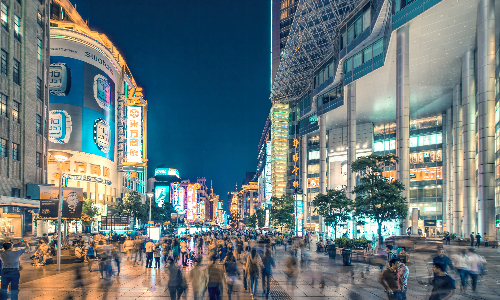
Today, the tour guide will escort you to the airport according to your departure time. Your 13-day Yangtze River Cruise Tour will come to an end at the airport. We hope you have a nice journey with China Tour Star and look forward to seeing you next time!
Author: Ren Jiayi
Proofreader: Vivian Zhou
| City | Five Star hotel list | Four Star hotel list |
|---|---|---|
| Beijing | Sunworld Dynasty Hotel Beijing Wangfujing | Sunworld Hotel Wangfujing |
| Xi'an | Tianyu Gloria Grand Hotel Xi'an | Sunworld Dynasty Hotel |
| Chengdu | Sofitel Chengdu Taihe | Holiday Inn Express Chengdu Jinniu |
| Yangtze River Cruise | Victoria Anna | Victoria Anna |
| Shanghai | Ocean Hotel Shanghai | Courtyard by Marriott Shanghai Central |
 |
![]() About your child or infant, please contact us for a discounted price.
About your child or infant, please contact us for a discounted price.



We started with a few days in Beijing & ended in Shanghai, from where we visited the Forbidden City and Great Wall. In between we visited Terra Cotta Warriors Museum, Panda Base, Shanghai Disneyland.

We had a wonderful holiday in China which will remain long in the memory. China is a breathtakingly beautiful country full of splendid temples and palaces, mountains and rivers, peaceful rural scenes and bustling shopping streets.
 QUICK ENQUIRY
QUICK ENQUIRY